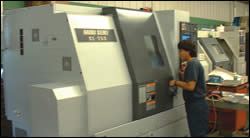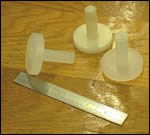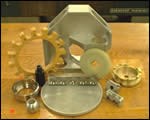Prototyping Has Its Place
This shop takes on prototype projects not only to lure production work, but also to educate its employees and demonstrate advanced machining capabilities to new and existing customers.
Share





"Nothing." That would be the reply you'd get if you asked Richard Alfoni how much his Rowley, Massachusetts, contract shop pockets after manufacturing a prototype part. It's for that reason that many shops in his neck of the woods no longer take on such one-off work. So why won't he turn down a prototype project, regardless of material type or part complexity? Because he's found there is more to machining a single prototype part than immediately turning a nickel.
Typically, the shop that machines a manufacturer's prototype is first in line to win any production work that may follow. So prototyping can stream income into a shop if the part makes it to the production stage.
However, Mr. Alfoni views prototyping not only as a lure for production work, but also as a continuing education tool for his employees. In addition, prototyping offers a chance to win over new customers, as well as to demonstrate advanced capabilities that might secure additional work from existing customers. Blending prototyping and production machining requires flexibility of personnel, equipment and business approach, and his shop Eastern Science is limber enough for this task.
Unique Beginning
If the name "Eastern Science" doesn't sound like a typical machine shop, that's because in many ways, it isn't (even though Mr. Alfoni might humbly say otherwise). The company was founded in 1919 by two MIT graduates who designed and built astronomy instruments. Until Mr. Alfoni took over the company from his father in 1972, it was run more like a "hobby shop" than a machine shop, where one-offs and prototypes were produced, but the production work was not sought.
Over the years, the company has amassed a significant knowledge base for effectively machining odd shapes and materials, including high-temperature alloys, titanium, plastics and ceramics. It currently puts that experience to work machining tight-toleranced parts for semiconductor, aerospace and medical customers on both manual and CNC machines. The biggest difference between now and pre-1972 is that the company's goal these days is to win the production work.
Why Prototype?
Mr. Alfoni capitalizes on prototype projects in a number of ways. First, these projects keep employees interested and excited about their work. "It's thrilling to know that a part you machined was a component of a rocket that was launched into space," Mr. Alfoni offers.
Prototyping also serves as on-the-job training for both new and experienced employees. This is particularly helpful, as Mr. Alfoni doesn't look for new hires with a specific background in metalworking (his CAD/CAM programmer has a degree in architecture). According to Mr. Alfoni, a person with a good attitude and willingness to learn makes for a good candidate.
A recent prototype job is a good example of how prototyping pushes employees to come up with unique processing solutions. It is a semiconductor part that measures 12 inches in diameter, is only 1/16-inch thick, has a small rectangular tab on the outer diameter and is needled with small holes. Like many other semiconductor parts that end up sandwiched together, surfaces must be parallel to within a couple ten-thousandths of an inch. "They offered the job to us and we told them we'd try it," says Mr. Alfoni. "We'll certainly use our vacuum workholder, but we'll probably have to lap that workholder to ensure the plate is perfectly flat, and we may also use pins to help secure the part." Even if this job doesn't develop into a production windfall, the exercise of devising a means to machine it may pay off down the line if the shop gets a part with a similar configuration.
Demonstrating a willingness to tackle different projects can attract new customers and help enter new markets. It also helps preserve good relationships with existing customers. "Our customers stick with us because we stick with them," says Mr. Alfoni. "There are some experimental projects that we know won't see the light of day, but we'll do it as a favor for key customers. That goes a long way toward nurturing a solid relationship."
Mr. Alfoni is not so altruistic in terms of providing employees with an educational experience that he loses sight of the fact that he is running a business. Prototyping positions the shop to win the production work, and the knowledge gained in terms of setup, tooling and machine parameters for prototypes translates to a quicker transition into production and quicker delivery to the customer.
Machine Mix
In the past, nearly every prototype job was performed on manual machines because setup was easier and faster. As the shop has gained experience with its CNC machines (its first CNC lathe machine was purchased in 1992), prototypes now might be machined on a CNC or combination of both machine types, depending on part quantity and geometry.
Eastern Science continues to add CNC equipment into its arsenal. For lathe work, the company mainly uses turning centers with live tooling from Mori Seiki (Irving, Texas). "We considered turn/mill machines, but we decided that turning centers with live tooling satisfied our need for turning and milling in one setup," explains Mr. Alfoni.
The shop also has a collection of Mycenter vertical machining centers from Kitamura (Wheeling, Illinois). The shop plays off CNC speed and repeatability by ganging parts whenever possible. It has found that taking the time to design a smart fixturing method pays dividends for production work.
The company's Premis CMM from Starrett (Athol, Massachusetts) offers a 3D CAD file import feature to speed inspection routine programming. "Many of the companies we serve don't realize this capability exists," says Greg Santiago, CMM operator. This feature can greatly reduce the time required for developing inspection routines for both prototypes and production work, making it much quicker than writing a routine from a part print.
Material Differences
Stereolithography, metal laser sintering and other rapid prototyping methods are certainly valuable in cases such as mold making. However, Eastern Science's customers need proof that their complex part can, in fact, be produced in the specified material. Because the shop has machined a wide variety of materials, it has a good notion of what style of tooling is required for exotic materials.
For high temperature alloys, the shop machines dry with high speed steel or diamond coated cutters. Plastics, including Ultem and G-10, tend to be very abrasive, which lowers tool life. The shop uses carbide tools for plastics such as these.
Five-flute carbide end mills are the cutters of choice for both roughing and finishing operations on ceramic parts. "It has been recommended to us to use diamond coated cutters for ceramics, but in our experience, diamond has a greater tendency to chip the ceramic," says Mr. Alfoni. "I'd rather go through a few $25 carbide end mills than use a $125 diamond end mill that may chip and scrap a ceramic part."
When dealing with very expensive materials, Eastern Science sometimes uses a lower-cost substitute material for job setup. For a recent part made from $550 per foot poly-chloro-trifluoro-ethylene (PCTFE), for example, the company used less-expensive Delrin to finalize the setup.
Providing More
Eastern Science tries to maintain a close relationship with customer part designers. That way, it can offer design changes to allow easier machining. It also strives to provide more than what the customer needs. For example, the shop may take the extra step to provide a much better surface finish than required in order to demonstrate its capabilities. "We noticed that a particular customer's product line was trending toward higher surface finishes, and this gave us an chance to show them that we are ready to take this next step with them," says Mr. Alfoni.
Because just about any shop can machine parts to specification, companies are looking for shops that can provide a little bit more. As Mr. Alfoni points out, "we're not a manufacturer; we're a service." For this reason, shops may find it helpful to rethink a policy of saying "no" to prototyping.
Read Next
Setting Up the Building Blocks for a Digital Factory
Woodward Inc. spent over a year developing an API to connect machines to its digital factory. Caron Engineering’s MiConnect has cut most of this process while also granting the shop greater access to machine information.
Read More5 Rules of Thumb for Buying CNC Machine Tools
Use these tips to carefully plan your machine tool purchases and to avoid regretting your decision later.
Read MoreBuilding Out a Foundation for Student Machinists
Autodesk and Haas have teamed up to produce an introductory course for students that covers the basics of CAD, CAM and CNC while providing them with a portfolio part.
Read More




























.jpg;maxWidth=300;quality=90)



